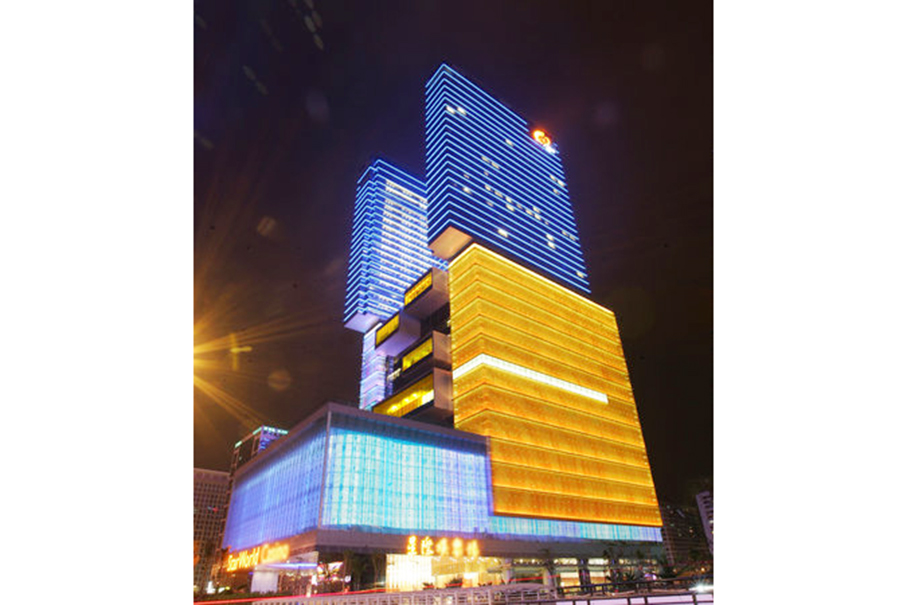Secretary for Transport and Public Works Raimundo do Rosário says that the government expects the Light Rail Transit (LRT) to become the residents’ major means of public transport within a few years, with public buses playing an auxiliary public transport role at that time, when the LRT service is extended to cover more areas in the city such as the peninsula’s Barra and Coloane’s Seac Pai Van district.
Rosário made the remarks during a one-day Q&A session in the legislature’s hemicycle on Friday about his portfolio’s policy guidelines for next year.
The policy secretary also said that the ongoing 180-day suspension of the LRT operation, which started in the middle of October, has not caused a major impact due to its low daily number of passengers, which had stood at just around 2,000 on average since the start of the COVID-19 pandemic early last year.
The LRT passenger service has been suspended since October 20 to replace the system’s high-voltage cables. The cable replacement is being carried out by Japan’s Mitsubishi Heavy Industries free of charge, the supplier of Macau’s LRT system and trains.
According to a government announcement in October about the 180-day service suspension, the LRT, which only covered Taipa and Cotai before its service was suspended, had been hit by a host of technical failures since it opened in December 2019, because of which the government decided to carry out a “holistic” investigation into the matter, the findings of which indicated that the repeated technical failures on the line were caused by the overheating of the high-voltage cables.
According to October’s announcement, the government decided to suspend the LRT’s passenger service for six months so that the replacement work can be carried out at full pace, instead of replacing the cables only during the non-service hours which would have taken two years, after considering the very low number of passengers during the COVID-19 pandemic.
At the time of its suspension, the LRT operated on the 9.3-kilometre-long Taipa section including Cotai. The Taipa-Cotai section, which started operating on December 10, 2019, has 11 stations.
The government’s ongoing project of the LRT section connecting Taipa and Barra at the southernmost tip of the peninsula – via Sai Van Bridge – is scheduled to be completed in 2023.
An LRT section connecting the Taipa line and Coloane’s sprawling Seac Pai Van public housing estate got off the ground in September. The Seac Pai Van LRT project is scheduled to be completed at the end of 2023.
The government is planning to build a sea-crossing LRT section connecting the Barrier Gate border checkpoint and the Taipa Ferry Terminal in Pac On via the Zone A and Zone E1 land reclamation areas. The government still does not have a schedule as to when the project, which is officially known as East Line, would get off the ground.
The number of LRT passengers had fallen drastically due to declining visitor number in the wake of the COVID-19 pandemic, after the system recorded an average daily number of passengers of 33,000 and 16,000 in December 2019 and January last year. Since the pandemic, the daily average number of LRT passengers had stood at around 2,000. Macau recorded its first COVID-19 case on January 22 last year.
The LRT system is owned by the local government but its operation has been outsourced to Hong Kong’s MTR Railway Operations (Macau) Company Limited.
Replying to questions from lawmakers during Friday’s Q&A session, Rosário said that the ongoing service suspension of the LRT Taipa section is saving the government money but he could not answer how much the government could save, adding that the government would release a more accurate calculation and estimation and give an answer as to how much the 180-day LRT suspension could be expected to save the public coffers.
Rosário also noted that the daily average number of LRT passengers had stood at just around 2,000 before the ongoing service suspension, because of which, he said, the suspension does not cause a major impact.
The policy secretary also said that the government has not received any complaints about the LRT service suspension.
Rosário also underlined that the LRT Taipa-Barra section could come into service at the end of 2023 or the beginning of 2024.
Rosário said he hoped that the LRT Macau-Hengqin section and Seac Pai Van section could open by the end of 2024.
Rosário noted that the LRT currently only has the Taipa section (which includes Cotai), adding he believed that after more LRT sections come into service in a few years’ time, the LRT would become the city’s major public transport means used by residents, with the public bus service then playing an auxiliary role for public transport.
The policy secretary also said that the daily average number of public bus passengers currently stands at around 600,000, because of which, he said, it would be impossible for the number of public bus trips to further increase.
Rosário also said that the government expects to launch a public tender early next year for the design and construction of the LRT East Line – which will cross the sea through an undersea tunnel. The policy secretary also insisted that for the time being it was difficult for the government to come up with an estimated budget for the LRT East Line project as it will have an undersea tunnel.
Wai Long possibly to switch from HOS to sandwich class housing
Meanwhile, Rosário also said that the government is studying whether the plot at the bottom of Big Taipa Hill in Avenida Wai Long – the plot of the ill-fated La Scala luxury housing project near the airport – should be used for sandwich class housing instead of subsidised home-ownership scheme (HOS) housing, after considering that the Zone A land reclamation area will have 24,000 HOS flats and that the latest round of applications for HOS flats, which ended last month, had fewer applicants compared to previous application rounds.
The government plans 32,000 residential flats on the 1.38-square-kilometre Zone A where 96,000 residents are expected to live. The 32,000 flats will comprise 24,000 HOS flats, 4,000 social housing units, and 4,000 flats in the private property market.
Rosário said that the government expects to complete drafting a bill regulating its sandwich class housing projects next year.
According to Rosário, the government has received around 11,000 applications in its latest round of applications, which started in July and ended last month, for around 5,200 HOS flats to be built in Zone A.
Rosário said that in the previous application round in late 2019 for around 3,000 HOS flats to be built in Zone A, the government received over 30,000 applications.
In the application round in late 2013 for 1,900 HOS flats in Seac Pai Van public housing estate, the government received around 40,000 applications.

Secretary for Transport and Public Works Raimundo do Rosário (not wearing a facemask) speaks during Friday’s Q&A session about his portfolio’s 2022 policy guidelines in the Legislative Assembly’s (AL) hemicycle. Photo: GCS







